Katrina Stories
New Mexico National Guard Saves Plaquemines Parish Animals
by SSG David Strobel, 9/23/05
When trying to rescue pets from a flooded home, it just doesn't seem fair to be chased by a large underwater predator.
Gary Stewart of the New Mexico National Guard thought he knew the risks of wading into the floodwater. "I think the lady who owned this place loved to knit because there was yarn everywhere, wrapped around everything," he said. "We crossed down power lines. We had to crawl over and under them to get to the dogs."
Stewart and MAJ Randy Brady,also of the New Mexico National Guard, had been tasked to feed horses and cows in Boothville, deep in the southern part of Plaquemines Parish. On the way back north, passing through Port Sulphur, "we heard all these dogs barking in a single wide trailer, a little one, only about 40 or 50 feet long," said 1LT Stewart.
The two had been in waders, but soon worried about how much protection they really needed. "We didn't see nothin," said MAJ Brady. "We just heard a big old splash and saw a lot of bubbles heading right for us. Whatever it was, it was big."
"The bubbles got closer and closer," said 1LT Stewart. "I called to the major, 'hey, I think we've got an alligator after us!' We got out of the water in a hurry."
The rescuers found a small, flat-bottomed boat. "We didn't have paddles, so we made a pair," said 1LT Stewart. "One was a 2 by 4, the other was a piece of molding from a trailer." The pair, now protected from attack, returned for the pets.
The dogs gave 1LT Stewart more trouble than expected, based on their size. "They were only about this big," said 1LT Stewart, with his hands less than two feet apart. "I think they were Pomeranians. They have sharp teeth!" One dog bit through his leather gloves, giving him a set of puncture marks in his left hand.
"I thought the dogs wanted to be saved," said 1LT Stewart. "They were in the windows, barking at everyone who drove past. Turns out not to be the case."
"It's amazing how many animals are down there," said MAJ Brady. "These dogs are so damned scared, they're hungry and tired. All these animals, just left behind."
The Senior Citizen Center had been converted to a collection point for animals rescued in Plaquemines Parish. Most of the pets awaiting reunion with their [guardians] were dogs, some cats. One was a calf, rescued the day before and waiting in the horse trailer owned by Linda Earnhart, an HSUS volunteer from Dallas. I asked her about how the New Mexico National Guard has helped rescue animals. "They've been wonderful, bringing us animals they've rescued," said Earnhart. "They tell us where the animals are that need rescue. The only thing that's kept animals alive is The National Guard bringing them food and water."
Plaquemines Parish vet, Dr. Stephen Hebert, had been almost overwhelmed with the animals brought to the temporary shelter. But he credits the New Mexico National Guard with helping him handle the flood of pets. "Totally fantastic, the things they've done for me," said Dr. Hebert. "I needed a secure place for the dogs, and they brought in wood, a backhoe and people to build all my pens for me. And they did it in a day. We had a horse on the other side of a barge that had blocked the road. The National Guard people helped me haul the hay across the barge to the horse."
Dr. Hebert pointed to two dogs walked by volunteers. "See these dogs? We have 200 here. So far, 33 people have been reunited with their dogs." Dr. Hebert said soldiers and airmen from New Mexico National Guard had helped save the lives of these animals. "Anything I ask for, it isn't 'no,' it's 'how do we make it happen.'"
"Aircraft 419, UH-60, mission 649 dash 20 is off at this time." Our Blackhawk picked us up at the Belle Chasse High School football field. Our mission was to find cattle that were starving to death. Someone had called the New Mexico National Guard command post, saying they had spotted a number (no one knew what number) of cows, stuck on a levee somewhere in the far southern part of Plaquemines Parish.
We cruised about 400 feet above the marshlands, the flooded homes and the Mississippi River, now back to normal. Below us, hundreds, maybe thousands of homes rested where the water had left them, scattered on their sides and far from where they should be. A red and white helicopter laid on its side and dead in the floodwaters, hundreds of boats of all sizes swamped and sunk or resting on land… as though a giant child had a tantrum and kicked over his playset community.
One of the voices on the aircraft's intercom breathed a hushed, "Wow" as we passed lower and slower. "Look at those fishing boats, beached right there on the levee." Another voice, and the pilot pointed, "That huge barge, way up on the land, that's gotta be a museum, right?" I answered, "No, that was washed up during Katrina." A pause, then. "Oh, wow…"
I looked out the open door and saw the stuff of people's lives leaked from their homes, spread for all to see… a dining room chair, magazines, bicycles, coolers, and hundreds of cars, pickups, vans… scattered on land and in water.
In Boothville, I saw oil tanks, emptied of their contents, surrounded by poisoned water, the water turned a sickly yellow, turning to green, turning to black. I remembered the scene in American Graffiti, when Harrison Ford insults the color of Paul LeMat's hot rod, "Sort of a cross between piss yellow and puke green ain't it?" I wondered if the movie's writer had ever seen a sight like this. It was a good source for a mortal insult.
Then, over the intercom, "There they are, I see them, at ten o'clock." Ahead and on our left were the cattle, standing on a grassy levee, several miles north of Venice and far west of the highway. I could see a dozen, two dozen, three dozen and a handful of horses. We flew low, checking their location and scanning the roads, seeing how to reach them and hopefully pull them out of harms way. We turned east to the river, then north, back to the command post. "Eight miles out, landing at Belle Chasse High School," the crew called on the radio. This one mission, out of 259 so far, accomplished.
We stopped about 20 miles from the true end of the road, in Venice, LA. "It's all the same from here on down," said outgoing B Company commander CPT Danny Olson, as he turned our Humvee around. We were doing a site survey, looking at our new area of operations. CPT Pia Romero was getting a briefing from the man she was replacing, called a "right seat ride."
Moments after we'd turned back north to our headquarters, MSgt Brad Nation called out, "Hey, there's a dog in that boat!" We walked back to a Jon boat sitting at an awkward angle, partially off of its trailer by the side of the road. Sure enough, there was a large black-and-white dog in the boat, and another small, weaker yellow dog lay nearby. The larger dog barked furiously as CPT Romero tried to calm him.
We had dog food but no cage. I supposed we could hold the two dogs on our laps. CPT Olson joined the hunt, but when cornered, the dogs just leaped into the polluted water, the same goop we were eager to keep off of ourselves. The yellow dog started to lap up the oily mess and all of us groaned at once. "Oh, please stop doing that," I called to the dog, who just looked up at me suspiciously.
As we wondered what to do next, a car with California plates and a camo rubber boat on top pulled up. I asked, "Are you folks with animal rescue?" The man and woman said they were, and would gladly get the dogs. The woman's name was Marey Christmas and her husband was Terry Jones. I took pictures as he splashed through the water, managing to snag the yellow dog but not her energetic companion.
We took the caged dog north, but only got about a mile down the road when MSgt Nation's sharp eyes spotted another dog, this time under a ruined single wide trailer that had slipped sidewise, half on the road and half in the ditch. The brown dog was very pregnant, hardly moving and, I quickly saw, was not alone. Another brown dog, with white highlights, lay beside and behind her, with her ribs showing. Both panted heavily, whether from fear or hunger or thirst, I could only guess.
As I stood to look for a rope to capture the dogs, my eyes locked with another pair of eyes. I froze. The dark, brown, unblinking eyes belonged to a large male pit bull, 10 feet away, inside the wall-less house. I spoke gently to him and he blinked. I climbed into the fallen home, between the wooden structure where drywall had been washed away by the flood. The dog panicked and scrambled to get out of the small room (so ruined that I could not tell what had been in the room before water carried debris and mud into it.) He had trouble squirming through the broken door, but managed to exit.
I followed as best as I could, lifting first a cupboard and then a table out of the way of the door, trying with limited success to keep my footing on the mud-slicked, tilted floor. Once in the next room, the dog looked for an escape. Finding none, he turned and faced me, shaking and whimpering. I grabbed a bathrobe from the muck, asked MSgt Nation for his knife, and cut free the thick hem. I found a piece of molding and asked MSgt Nation to cut a notch in it. I then had a field expedient leash and deployment pole. While softly talking to the dog, I carefully lifted the pole and leash over his head, gently tugging on the leash to tighten it. Slowly, slowly… and I had him. Still whimpering but not attacking as I expected, I led the dog out through the sprung and partially open front door, handing him off to MSgt Nation.
I looked around for another leash, finding a power cord to the family's iron. I cut it free, tied a loop into the end and took it along with the notched molding, outside for the other dogs. I worked my way under the home.
Momma was upset (I don't blame her) but too weak to fight or evade as I slipped the power cord leash around her neck, speaking reassurances all the while. I pulled the cord tight, crawled backwards into the sun and persuaded her to follow, handing the makeshift leash to CPT Romero.
Once more into the house for supplies, once more slipping on the mud and off-kilter floor (but not quite into the slime and muck) and I found a telephone cord for a third leash. Back under the house, another yellow dog spoken to gently, another doggy neck surrounded by a leash, and a third dog was blinking and shuddering in the sunshine.
So what to do with the dogs? We looked south, waiting a few mements for the California couple. Instead, we saw a military truck, filled with New Mexican soldiers and airmen, medics getting a firsthand look at the troubles. We decided to load the dogs into the truck, since they had room on the floor. I lifted the two yellow dogs into the truck, then looked at the pit bull. He returned a steady gaze without wagging his tail… neither looking promising for a friendly encounter.
CPT Olson and I made a couple of half-hearted tries, but as soon as the pit bull made a noise or moved to see what the hell these two guys were doing back where he couldn't see, we stopped and moved back. Finally, I took a deep breath (difficult in this humidity, no less the smell) held the dog and gently lifted him into the back of the truck. No problems from the dog, not even a whimper.
I climbed into the truck, holding the pit bull's leash and petting his nervous yellow mates. Approaching Port Sulphur, we were flagged down by a family with two destroyed tires on their pickup truck. They asked for our help and we offered to give them a lift, carrying one of the rims for a new tire. Then CPT Romero pointed behind the family and said, "Look, another dog!" A small, yellow (what is it with yellow dogs around here?) dog with bright eyes and a perky disposition trotted to us, looking for a handout or some friendly attention. I got her a handful of dog food and she spent the next 20 minutes coaxing it to her. She got her hand on the scruff of the dog's neck, I took hold, slipped my belt over the neck and carried it back to the humvee.
A long ride back and we handed the animals to a volunteer at the emergency shelter. As we were leaving, a middle-aged man walked out with a small yellow dog trotting behind him. The man had reunited with his dog, and both were happy, relieved. I hoped the animals we'd just rescued had as positive a future as these two.
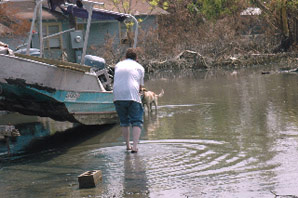
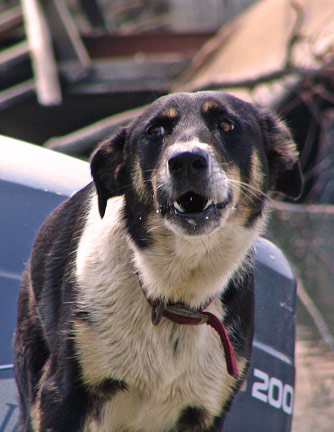
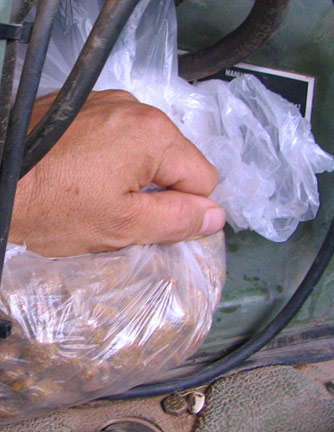
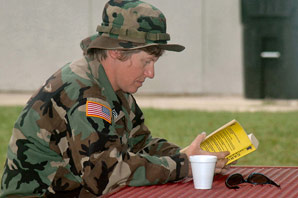
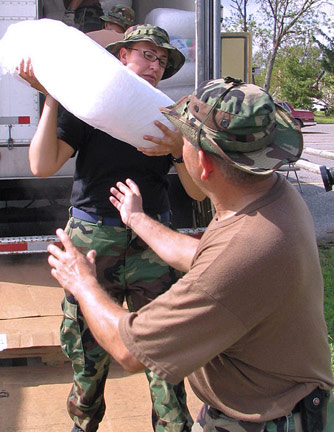
A Will To Live, Even Here
Photos are from the New Mexico National Guard, given to Kinship Circle along with transcripts about the unti's heroic rescue of dogs, cats, cows and horses stranded by Hurricane Katrina. In Plaquemines, a Katrina ravaged area least canvassed by large national animal groups, guard troops saved countless lives.
Here, Katrina tossed buildings and cars as if they were toys. East and West Bank levees crumbled. Damaged oil tanks spilled millions of gallons of black crude. Still, life persevered. Dogs and cats swarmed National Guardsmen for food and water. Bewildered horses tried to rise in swampy fields. Cows floated in mucky water.
Early after the storm, Kinship Circle contacted New Mexico National Guard to gain access into no-go Plaquemines and found a kindred spirit in Major Kimberly Lalley. Soon teams led by Chris and Sarah Stevens, with Terri Kelley, cleared security checkpoints via permission from Colonel Dick Almeter – as the first out-state rescuers in Plaquemines. Today, it's eerily quiet. Sprawling FEMA trailer parks are home to most in lower Plaquemines. A detached school roof hangs over empty rooms. Shredded toys wait for a child. Here, animals survive.
Photos are from the New Mexico National Guard, given to Kinship Circle along with transcripts about the unti's heroic rescue of dogs, cats, cows and horses stranded by Hurricane Katrina. In Plaquemines, a Katrina ravaged area least canvassed by large national animal groups, guard troops saved countless lives.
Here, Katrina tossed buildings and cars as if they were toys. East and West Bank levees crumbled. Damaged oil tanks spilled millions of gallons of black crude. Still, life persevered. Dogs and cats swarmed National Guardsmen for food and water. Bewildered horses tried to rise in swampy fields. Cows floated in mucky water.
Early after the storm, Kinship Circle contacted New Mexico National Guard to gain access into no-go Plaquemines and found a kindred spirit in Major Kimberly Lalley. Soon teams led by Chris and Sarah Stevens, with Terri Kelley, cleared security checkpoints via permission from Colonel Dick Almeter – as the first out-state rescuers in Plaquemines. Today, it's eerily quiet. Sprawling FEMA trailer parks are home to most in lower Plaquemines. A detached school roof hangs over empty rooms. Shredded toys wait for a child. Here, animals survive.
This Is Baby Noah…
A no-name kitten from Plaquemines. His new name reflects the NOLA term of endearment Baby, and the epic floods, Noah. Kinship Circle's Brenda Shoss adopted the tiny tuxedo, who came home as part of the group's transport for out-state adoptions.
A no-name kitten from Plaquemines. His new name reflects the NOLA term of endearment Baby, and the epic floods, Noah. Kinship Circle's Brenda Shoss adopted the tiny tuxedo, who came home as part of the group's transport for out-state adoptions.



